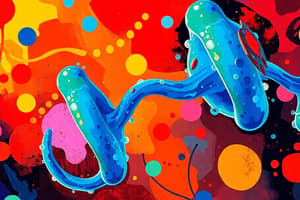Podcast
Questions and Answers
What does thermodynamics primarily describe?
What does thermodynamics primarily describe?
- Exchange of energy between a system and its environment. (correct)
- The behavior of ideal gases.
- The relationships between different forms of matter.
- The conversion of chemical energy into thermal energy.
Which of the following is an example of an extensive state variable?
Which of the following is an example of an extensive state variable?
- Volume (correct)
- Concentration
- Pressure
- Temperature
What does the first law of thermodynamics state?
What does the first law of thermodynamics state?
- Energy is conserved and can only change forms. (correct)
- Energy can be created and destroyed.
- Energy cannot do work.
- Energy can be lost during a phase change.
Which of the following pairs of variables includes one intensive and one extensive variable?
Which of the following pairs of variables includes one intensive and one extensive variable?
In thermodynamics, what does the symbol ∆U represent?
In thermodynamics, what does the symbol ∆U represent?
What is the relationship between Gibbs free energy change and redox potential in the context of electron transfer?
What is the relationship between Gibbs free energy change and redox potential in the context of electron transfer?
In which state are nutrients primarily stored as glycogen, protein, and fat?
In which state are nutrients primarily stored as glycogen, protein, and fat?
What drives the synthesis of ATP in the electron transport chain?
What drives the synthesis of ATP in the electron transport chain?
What is the role of electronegativity in chemical bonding?
What is the role of electronegativity in chemical bonding?
Which of the following accurately describes the process of respiration?
Which of the following accurately describes the process of respiration?
What occurs during the basal (overnight fast) state?
What occurs during the basal (overnight fast) state?
What is the effect of uncoupling in brown fat cells?
What is the effect of uncoupling in brown fat cells?
In the context of electron transport, what does the equation ∆μ = - n F ∆E represent?
In the context of electron transport, what does the equation ∆μ = - n F ∆E represent?
What role do chaperones play in protein folding?
What role do chaperones play in protein folding?
What happens to proteins when they are subjected to denaturing conditions?
What happens to proteins when they are subjected to denaturing conditions?
Which structure forms first during protein folding?
Which structure forms first during protein folding?
What is the function of Hsp70 in a cell?
What is the function of Hsp70 in a cell?
How does the behavior of ATP synthase relate to conformational changes in proteins?
How does the behavior of ATP synthase relate to conformational changes in proteins?
What typically triggers the proteasome to degrade a protein?
What typically triggers the proteasome to degrade a protein?
What is the primary function of allosteric inhibitors in proteins?
What is the primary function of allosteric inhibitors in proteins?
What is the impact of acid on protein structure?
What is the impact of acid on protein structure?
What is the significance of hydrophobic effects in protein folding?
What is the significance of hydrophobic effects in protein folding?
What effect does a low pH (high H+ concentration) have on hemoglobin?
What effect does a low pH (high H+ concentration) have on hemoglobin?
Which type of fatty acid contains only single bonds between carbon atoms?
Which type of fatty acid contains only single bonds between carbon atoms?
What is a primary characteristic of unsaturated fatty acids?
What is a primary characteristic of unsaturated fatty acids?
What forms the basic structure of triacylglycerols?
What forms the basic structure of triacylglycerols?
Which lipid is primarily responsible for cell membrane fluidity?
Which lipid is primarily responsible for cell membrane fluidity?
What distinguishes phospholipids from other lipids?
What distinguishes phospholipids from other lipids?
What is the main component generated by normal metabolism that contributes to acidity in the body?
What is the main component generated by normal metabolism that contributes to acidity in the body?
How are glycolipids different from phospholipids?
How are glycolipids different from phospholipids?
What characteristic of a buffer determines its effectiveness in resist changes in pH?
What characteristic of a buffer determines its effectiveness in resist changes in pH?
What type of bond involves the sharing of an electron pair between two atoms with similar electronegativity?
What type of bond involves the sharing of an electron pair between two atoms with similar electronegativity?
What type of bonds do saturated fatty acids form, contributing to their solid state at room temperature?
What type of bonds do saturated fatty acids form, contributing to their solid state at room temperature?
What defines a hydrogen bond in water?
What defines a hydrogen bond in water?
What is the consequence of the presence of trans double bonds in fatty acids?
What is the consequence of the presence of trans double bonds in fatty acids?
Which statement best describes ionic bonds?
Which statement best describes ionic bonds?
What typically occurs during non-hydrogen dipole interactions?
What typically occurs during non-hydrogen dipole interactions?
What is a common feature of induced dipoles?
What is a common feature of induced dipoles?
What type of bonding occurs when there is a significant difference in electronegativity between two atoms?
What type of bonding occurs when there is a significant difference in electronegativity between two atoms?
Which statement is true regarding London dispersion forces?
Which statement is true regarding London dispersion forces?
What is the relationship between electronegativity and the tendency of an atom to gain electrons?
What is the relationship between electronegativity and the tendency of an atom to gain electrons?
What is the relationship between entropy and spontaneous reactions?
What is the relationship between entropy and spontaneous reactions?
For a process to occur spontaneously in an isolated system, which statement is true?
For a process to occur spontaneously in an isolated system, which statement is true?
In an open system, under what condition will processes occur spontaneously?
In an open system, under what condition will processes occur spontaneously?
What does the Gibbs free energy (G) indicate about a system?
What does the Gibbs free energy (G) indicate about a system?
How is the entropy of the environment related to heat exchange in a system?
How is the entropy of the environment related to heat exchange in a system?
What does the equation ∆G = ∆Hsys - T∆Ssys indicate?
What does the equation ∆G = ∆Hsys - T∆Ssys indicate?
What is the significance of a negative change in Gibbs free energy (∆G < 0)?
What is the significance of a negative change in Gibbs free energy (∆G < 0)?
Which relationship does the Henderson-Hasselbalch equation express?
Which relationship does the Henderson-Hasselbalch equation express?
What does the term 'equilibrium' refer to in a thermodynamic context?
What does the term 'equilibrium' refer to in a thermodynamic context?
Which of the following describes a characteristic of weak acids?
Which of the following describes a characteristic of weak acids?
Flashcards
Thermodynamics
Thermodynamics
The study of how energy is exchanged between a system and its surroundings. This encompasses various energy forms and their transformations for doing work.
State Variables
State Variables
Properties that describe the state of a system at a specific moment. They don't depend on how the system reached that state.
Extensive State Variable
Extensive State Variable
State variables that add up when combining two systems. For example, the total volume of two combined containers is the sum of their individual volumes.
Intensive State Variable
Intensive State Variable
Signup and view all the flashcards
Internal Energy (U or E)
Internal Energy (U or E)
Signup and view all the flashcards
Entropy (S)
Entropy (S)
Signup and view all the flashcards
Second Law of Thermodynamics
Second Law of Thermodynamics
Signup and view all the flashcards
Isolated System
Isolated System
Signup and view all the flashcards
Open System
Open System
Signup and view all the flashcards
Entropy of the Environment
Entropy of the Environment
Signup and view all the flashcards
Gibbs Free Energy (G)
Gibbs Free Energy (G)
Signup and view all the flashcards
Spontaneous Process
Spontaneous Process
Signup and view all the flashcards
Acid
Acid
Signup and view all the flashcards
Base
Base
Signup and view all the flashcards
pH
pH
Signup and view all the flashcards
Protein Folding
Protein Folding
Signup and view all the flashcards
Hydrophobic Effect
Hydrophobic Effect
Signup and view all the flashcards
Chaperone
Chaperone
Signup and view all the flashcards
Denaturation
Denaturation
Signup and view all the flashcards
Hsp70
Hsp70
Signup and view all the flashcards
Hsp60
Hsp60
Signup and view all the flashcards
Conformational Change
Conformational Change
Signup and view all the flashcards
Proteasome
Proteasome
Signup and view all the flashcards
Buffer
Buffer
Signup and view all the flashcards
Electronegativity
Electronegativity
Signup and view all the flashcards
Covalent bond
Covalent bond
Signup and view all the flashcards
Ionic bond
Ionic bond
Signup and view all the flashcards
Polar molecule
Polar molecule
Signup and view all the flashcards
Hydrogen bond
Hydrogen bond
Signup and view all the flashcards
London dispersion force
London dispersion force
Signup and view all the flashcards
Induced dipole
Induced dipole
Signup and view all the flashcards
Debeye force
Debeye force
Signup and view all the flashcards
Allosteric inhibitor
Allosteric inhibitor
Signup and view all the flashcards
Allosteric activator
Allosteric activator
Signup and view all the flashcards
2,3-BPG and Hemoglobin
2,3-BPG and Hemoglobin
Signup and view all the flashcards
Bohr Effect
Bohr Effect
Signup and view all the flashcards
Plasma Membrane
Plasma Membrane
Signup and view all the flashcards
Fatty Acid
Fatty Acid
Signup and view all the flashcards
Saturated Fatty Acid
Saturated Fatty Acid
Signup and view all the flashcards
Unsaturated Fatty Acid
Unsaturated Fatty Acid
Signup and view all the flashcards
Triacylglycerol
Triacylglycerol
Signup and view all the flashcards
Phospholipid
Phospholipid
Signup and view all the flashcards
Electron Transport Chain (ETC)
Electron Transport Chain (ETC)
Signup and view all the flashcards
Proton Motor Force (PMF)
Proton Motor Force (PMF)
Signup and view all the flashcards
Oxidative Phosphorylation
Oxidative Phosphorylation
Signup and view all the flashcards
Basal State (Overnight Fast)
Basal State (Overnight Fast)
Signup and view all the flashcards
Postprandial State (Fed)
Postprandial State (Fed)
Signup and view all the flashcards
Respiration
Respiration
Signup and view all the flashcards
Fermentation
Fermentation
Signup and view all the flashcards
Study Notes
Biochemistry Summary
- This document is a summary of Biochemistry (AB_1137).
- It covers various topics within the subject, including Thermodynamics, Interactions, Proteins, Ligand binding, Enzymes, Membranes, Transport, Redox reactions, Electron transport chain and oxidative phosphorylation, and Metabolism.
- The document provides detailed information for each topic.
Studying That Suits You
Use AI to generate personalized quizzes and flashcards to suit your learning preferences.




